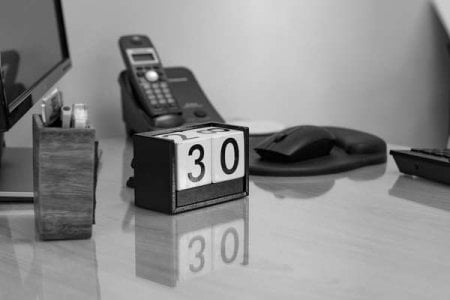Heads up, retirees! One missed action before June 30 could cost you BIG...
By
Danielle G.
- Replies 0
As the end of the financial year approaches, thousands of Australian retirees are racing the clock to tick off an important item on their financial to-do list. It’s not just lodging tax returns or making last-minute super contributions – it’s ensuring you’ve withdrawn enough from your superannuation before June 30. For anyone drawing a retirement income stream from super, “Don’t miss the deadline!” is the ATO’s emphatic reminder. Failing to withdraw the required minimum amount by June 30 might sound like a trivial slip, but it “could result in adverse taxation consequences” for the retiree. In plain English: miss this deadline and you could face an unwelcome tax bill or a lot of financial hassle at a time when life is supposed to be simpler.
“It’s a timely reminder,” notes Retirement Essentials, a specialist advisory service for seniors, “for anyone drawing an income from an Account-Based Pension (ABP) to double-check they’ve met their minimum annual withdrawal requirement”. Overlooking this vital rule, experts warn, can have unintended repercussions. One major accounting firm cautions that “this oversight could prove to be a costly error”, potentially stripping away tax exemptions and slugging your fund with up to 15% tax on earnings that would otherwise have been tax-free. In other words, a simple missed withdrawal could hit your hip pocket hard – something no retiree wants when every dollar counts.
Under Australia’s superannuation rules, once you convert your super into an income stream (often called an account-based pension), you’re required to withdraw a minimum amount each financial year. This minimum is calculated as a percentage of your account balance and it varies with your age. It starts at 4% of your balance for those under 65, then climbs to 5% for ages 65–74, 6% for 75–79, and keeps rising – reaching 14% for those 95 or older. The idea is to gradually draw down your nest egg over time rather than hoard it indefinitely. For example, a 70-year-old with an account-based pension needs to withdraw at least 5% of their account balance this year, and that requirement jumps to 6% once they turn 75. These percentages are the government’s way of nudging us to use our retirement savings for, well, retirement.
Importantly, this rule only kicks in once your super is in “pension mode.” If your super is still sitting in an accumulation account (where it’s just growing and you haven’t begun a retirement income stream), there’s no law forcing you to take money out yet. “You do not have to start withdrawing — the choice is yours,” explains Steven Sadler, Head of Customer Service at Retirement Essentials, clarifying that there’s no fixed “retirement age” in Australia that mandates cashing out your super. In practice, many people choose to start an account-based pension when they retire (or reach the eligible age) to take advantage of super’s tax-free earnings in pension phase. But with that tax perk comes the trade-off: the minimum withdrawal rule.
It’s also worth noting what doesn’t count toward that minimum. “A little-known fact”, as Retirement Essentials points out, is that lump sum withdrawals don’t count toward your annual minimum. Only the regular pension payments (the income stream from your ABP) satisfy the requirement. So if you, say, withdrew a big one-off lump sum from your pension account this year to help the kids or grandkids, be careful – you still need to pay yourself the required pension amount separately. The government wants to see a steady income stream coming out, not just occasional chunks.
And what if you’re still working part-time or only semi-retired but have started tapping your super? The same rule applies. Some seniors get tripped up on this: one retiree asked if receiving a small Age Pension means she must start withdrawing from super. The answer: not unless you’ve actually begun an account-based pension. If you haven’t started an ABP, the minimum drawdown rule doesn’t apply – but if you have, even part-way into retirement, you must meet the minimum. The Age Pension from Centrelink is a separate system; it doesn’t trigger super withdrawal requirements. In short, it’s the type of super account that matters – accumulation (no mandatory withdrawals) versus pension/income stream (mandatory withdrawals by June 30 each year).
June 30 isn’t just a random date – it’s the final day of Australia’s financial year, and therefore the hard deadline for meeting your annual minimum withdrawal. If the minimum payment is not made by 30 June, the consequences kick in on 1 July. In fact, tax law is pretty strict on this: if you fall short, your super income stream is deemed to have ceased at the start of that financial year for tax purposes. Yes, you read that right – miss the deadline by a day, and it’s as if your pension didn’t exist for the entire year in the taxman’s eyes.
What does that mean practically? For one, your super fund loses the tax-free status on investment earnings that applied while in pension phase. Earnings in an account-based pension are usually tax-exempt (a great perk for retirees), but that benefit hinges on you following the rules. If you didn’t withdraw enough, the ATO can say, “Sorry, you didn’t really have a pension this year,” and those earnings become taxable. Your fund may “not be able to claim Exempt Current Pension Income (ECPI)” – meaning up to 15% tax on income that would have been tax-free. That’s a nasty surprise to uncover after the fact.
There’s more. Any withdrawals you did make during the year could be reclassified as lump sum withdrawals instead of pension payments. That matters because pension payments are usually tax-free for people over 60, whereas lump sums for younger retirees or from certain components might attract tax. It also messes with your record-keeping. Essentially, the government hits the reset button on your account-based pension. You’d be forced to stop and restart your retirement income stream (with paperwork to match). Think of it like your pension going into penalty time-out: you’d have to formally recommence it in the new financial year, which can involve recalculating how much of your balance is tax-free versus taxable, revaluing your assets if it’s an SMSF, and re-reporting things to the ATO.
For those of us with self-managed super funds (SMSFs), the ATO’s hard line on this can create a mountain of admin. The compliance burden falls squarely on the trustees (often you and your spouse). If you miss the minimum, you may need to revalue all your fund’s assets to their market value at the time you restart the pension, recalculate the tax-free and taxable portions of your benefits, lodge corrected reports to the ATO, and essentially begin a new pension account from scratch. It’s paperwork galore, often requiring an accountant or advisor to untangle – not to mention the stress and cost involved in fixing the mistake. One industry consultant summed it up bluntly: failing to meet the minimum pension standards will trigger reductions in your fund’s ECPI claim and can even alter the mix of your benefit’s tax components, with Transfer Balance Account implications to boot. In everyday terms, it’s a big mess to clean up once that line is crossed.
Now, before panic sets in, there is a slight safety net for truly honest mistakes. The regulations provide a narrow exception if your shortfall was due to an innocent error or factors beyond your control (say, a banking glitch or a timing issue) – and you make up the shortfall quickly once discovered. You can self-assess this one-time exception, meaning the ATO allows you to pretend the pension never stopped, but you only get to use this mulligan once in your life in most cases. If it happens again in future years, you’ll have to apply to the ATO for discretion and plead your case. In other words: they might forgive one whoopsie if you fix it promptly, but don’t count on being let off the hook twice. The clear message is to get it right the first time – or be prepared to deal with the fallout.
It’s also worth noting that if you’re in a large retail or industry super fund, you’re less likely to accidentally miss the minimum – these funds usually automatically ensure the required payments are made (often by default or with a gentle prod to members). The systems are set up so that by June 30, you’ve been paid what you need to be paid. However, ultimately the responsibility is still yours to confirm it happened, especially if you’ve changed payment frequencies or made extra withdrawals. For SMSF holders, no automated safety net exists – vigilance is your only protection. As one retiree, Ray, noted in a discussion about SMSFs, these compliance issues don’t just affect your income – “they can also affect your estate” planning and what you leave behind. A lapsed pension could, for example, change how remaining super funds are treated upon death, potentially altering beneficiaries’ tax outcomes. So the ripple effects of a missed minimum can extend far beyond one tax year.
While many retirees fret about meeting the minimum, there’s another side to the coin: are you withdrawing enough for your own lifestyle? Interestingly, a lot of seniors default to only taking the minimum each year, assuming that’s the sensible, maybe even recommended, thing to do. After all, conventional wisdom in retirement often boils down to “don’t spend your savings too fast.” However, it’s important to realize that the mandated minimum is exactly that – a legal minimum, not a personalized financial plan. As Retirement Essentials puts it, “it’s a regulatory floor, not a financial plan.” It’s the lowest amount you’re required to take out, but it’s certainly not automatically the “right” amount for everyone.
Every retiree’s situation is different. The rule doesn’t care if you have other income sources or if you’re living frugally or lavishly – it just sets a floor. But your optimal drawdown rate might be higher (or, if rules allowed, even lower) depending on your needs. Some people stick to the minimum and reinvest any extra earnings in super, aiming to preserve their balance for as long as possible (sometimes with thoughts of leaving an inheritance). Others might find the minimum far below what they actually need to live comfortably, so they withdraw more. There’s no maximum withdrawal – you can even pull out your entire balance if you really want (though that could have other consequences, like losing the future tax-free earning environment). The key is that the “right” amount to withdraw “depends upon your retirement income mix, lifestyle needs, spending patterns, and broader financial goals”.
For instance, if you have a modest super balance but also receive the Age Pension and maybe some investment income, you might not need to tap heavily into super each year. Conversely, someone with a larger super balance and no pension might plan to draw more than the minimum to fund travel in the early active years of retirement. The minimum rules should not be mistaken for financial advice; they’re more like a drawdown speed limit sign – you’re not allowed to go any slower than this on the retirement road, but you can certainly go faster if it suits your journey.
There’s also a behavioral aspect: after decades of saving diligently, it can be psychologically hard for retirees to switch to spending mode. Many end up underspending, withdrawing only the minimum and watching their super balance barely shrink or even grow. While it’s great to be frugal, remember that superannuation was designed to be used for your retirement lifestyle. One common myth is that taking out more income will wreck your Age Pension entitlements, leading some to err on the side of taking less. In reality, the interaction between your super withdrawals and Centrelink benefits is a bit complex but often misunderstood.
Here’s the good news: Centrelink doesn’t directly count how much money you pull out of super each year for most retirees – it mainly cares about your assets and the deemed income on those assets. For account-based pensions started after 2014, Centrelink uses deeming rules based on your account balance, not your actual withdrawals. As long as you stay above the minimum, whether you withdraw 5% or 8% of your balance this year generally won’t change your Age Pension payment by a big amount, because Centrelink is assuming a certain rate of return (the deeming rate) on your investments regardless. One retiree, Lance, was surprised to learn that even though he was drawing more than the minimum from his super, “the impact on his Age Pension was small”. Why? Because deeming rates have been low in recent years, and his higher withdrawals didn’t suddenly count as extra “income” in Centrelink’s eyes. In short, you shouldn’t starve your lifestyle out of fear that withdrawing a bit more will slash your pension; often it won’t. (Of course, every case is different, and those with older “grandfathered” pensions or very high balances should get specific advice – but the principle stands for many).
All this is to say, don’t treat the minimum drawdown as gospel for your personal spending. Treat it as a safety floor. By all means, if you don’t need more, keep it invested – but if you do need more, or simply want to enjoy more of your hard-earned savings now, remember that the rules allow it. The government sets a minimum to ensure you use your super for its intended purpose, but deciding the optimal withdrawal rate beyond that minimum is up to you and perhaps your financial adviser. Balancing longevity risk (not outliving your money) with quality of life is the eternal juggle in retirement planning. Just know that the minimum withdrawal is a tool, not a target. As one retirement commentator quipped, having only the minimum as your plan is like going on a road trip and only putting the absolute minimum fuel in the tank – sure, you meet the requirement, but are you really prepared for the journey you want?
Back to the immediate concern: June 30 is around the corner. If you’re now double-checking your situation (and you should if you haven’t already), here are some practical steps to make sure you’re in the clear:
One common last-minute question is: “Will I pay tax on these withdrawals?” The general answer for over-60s is no – withdrawals from a taxed super fund in pension phase are tax-free to you personally. But if you’re between preservation age and 60, or your super has untaxed elements (rare), there could be some tax, and any withdrawals while you’re under 60 might need to be declared. The point is, make sure you understand your own situation so there are no surprises. Most retirees over 60 can rest easy that meeting the minimum won’t generate a tax bill for them (it’s the fund that faces the tax consequences if you don’t meet it). Yet another reason to comply with the rules – better the money in your pocket than in the Tax Office’s coffers.
Let’s face it: dealing with super rules and deadlines isn’t exactly the fun part of retirement. It can feel like paperwork and red tape at a stage of life when things should be simpler. As one retiree, Marcia, commented, some of these rules “can feel punitive.” After a lifetime of form-filling and bill-paying, it’s understandable that many over-60s are fed up with “homework” from the government. But clarity and action now can save you a world of pain later. The minimum drawdown rule might seem like just another pesky obligation – “annoying red tape,” even, as Retirement Essentials describes it – yet overlooking it can carry real weight. From losing valuable tax exemptions to potentially affecting Age Pension eligibility, this is a detail that’s small on effort but big on impact.
The silver lining is that once you’ve double-checked and ensured you’re on track for this year, you can breathe easier and know you’ve maximized the benefits of your retirement savings as intended. Consider it an annual check-up for your super – not unlike servicing a car or getting a health screening. It’s a routine that, while tedious, keeps everything running smoothly. And with each year you successfully navigate the rules, it becomes just that little bit more routine.
So, with the June 30 deadline nearly here, take a moment to ensure you’ve taken what you need to take. Enjoy the tax-free income if you have it, and avoid those penalties. Then, perhaps reward yourself for the diligence – after all, this money is there to support your life. Have you done what’s needed to secure your financial footing this year? And looking beyond the deadline: what’s your strategy to balance playing by the rules with living the retirement you want? It’s a question worth pondering as you toast (maybe with a nice cuppa or a glass of wine) to another financial year gone by, hopefully with no nasty surprises in store. How will you make the most of your hard-earned super without tripping over the fine print – and do you think these rules help or hinder retirees in the long run?
“It’s a timely reminder,” notes Retirement Essentials, a specialist advisory service for seniors, “for anyone drawing an income from an Account-Based Pension (ABP) to double-check they’ve met their minimum annual withdrawal requirement”. Overlooking this vital rule, experts warn, can have unintended repercussions. One major accounting firm cautions that “this oversight could prove to be a costly error”, potentially stripping away tax exemptions and slugging your fund with up to 15% tax on earnings that would otherwise have been tax-free. In other words, a simple missed withdrawal could hit your hip pocket hard – something no retiree wants when every dollar counts.
What’s the Rule and Who Does It Affect?
Under Australia’s superannuation rules, once you convert your super into an income stream (often called an account-based pension), you’re required to withdraw a minimum amount each financial year. This minimum is calculated as a percentage of your account balance and it varies with your age. It starts at 4% of your balance for those under 65, then climbs to 5% for ages 65–74, 6% for 75–79, and keeps rising – reaching 14% for those 95 or older. The idea is to gradually draw down your nest egg over time rather than hoard it indefinitely. For example, a 70-year-old with an account-based pension needs to withdraw at least 5% of their account balance this year, and that requirement jumps to 6% once they turn 75. These percentages are the government’s way of nudging us to use our retirement savings for, well, retirement.
Importantly, this rule only kicks in once your super is in “pension mode.” If your super is still sitting in an accumulation account (where it’s just growing and you haven’t begun a retirement income stream), there’s no law forcing you to take money out yet. “You do not have to start withdrawing — the choice is yours,” explains Steven Sadler, Head of Customer Service at Retirement Essentials, clarifying that there’s no fixed “retirement age” in Australia that mandates cashing out your super. In practice, many people choose to start an account-based pension when they retire (or reach the eligible age) to take advantage of super’s tax-free earnings in pension phase. But with that tax perk comes the trade-off: the minimum withdrawal rule.
It’s also worth noting what doesn’t count toward that minimum. “A little-known fact”, as Retirement Essentials points out, is that lump sum withdrawals don’t count toward your annual minimum. Only the regular pension payments (the income stream from your ABP) satisfy the requirement. So if you, say, withdrew a big one-off lump sum from your pension account this year to help the kids or grandkids, be careful – you still need to pay yourself the required pension amount separately. The government wants to see a steady income stream coming out, not just occasional chunks.
And what if you’re still working part-time or only semi-retired but have started tapping your super? The same rule applies. Some seniors get tripped up on this: one retiree asked if receiving a small Age Pension means she must start withdrawing from super. The answer: not unless you’ve actually begun an account-based pension. If you haven’t started an ABP, the minimum drawdown rule doesn’t apply – but if you have, even part-way into retirement, you must meet the minimum. The Age Pension from Centrelink is a separate system; it doesn’t trigger super withdrawal requirements. In short, it’s the type of super account that matters – accumulation (no mandatory withdrawals) versus pension/income stream (mandatory withdrawals by June 30 each year).
Why June 30 Is Non-Negotiable
June 30 isn’t just a random date – it’s the final day of Australia’s financial year, and therefore the hard deadline for meeting your annual minimum withdrawal. If the minimum payment is not made by 30 June, the consequences kick in on 1 July. In fact, tax law is pretty strict on this: if you fall short, your super income stream is deemed to have ceased at the start of that financial year for tax purposes. Yes, you read that right – miss the deadline by a day, and it’s as if your pension didn’t exist for the entire year in the taxman’s eyes.
What does that mean practically? For one, your super fund loses the tax-free status on investment earnings that applied while in pension phase. Earnings in an account-based pension are usually tax-exempt (a great perk for retirees), but that benefit hinges on you following the rules. If you didn’t withdraw enough, the ATO can say, “Sorry, you didn’t really have a pension this year,” and those earnings become taxable. Your fund may “not be able to claim Exempt Current Pension Income (ECPI)” – meaning up to 15% tax on income that would have been tax-free. That’s a nasty surprise to uncover after the fact.
There’s more. Any withdrawals you did make during the year could be reclassified as lump sum withdrawals instead of pension payments. That matters because pension payments are usually tax-free for people over 60, whereas lump sums for younger retirees or from certain components might attract tax. It also messes with your record-keeping. Essentially, the government hits the reset button on your account-based pension. You’d be forced to stop and restart your retirement income stream (with paperwork to match). Think of it like your pension going into penalty time-out: you’d have to formally recommence it in the new financial year, which can involve recalculating how much of your balance is tax-free versus taxable, revaluing your assets if it’s an SMSF, and re-reporting things to the ATO.
For those of us with self-managed super funds (SMSFs), the ATO’s hard line on this can create a mountain of admin. The compliance burden falls squarely on the trustees (often you and your spouse). If you miss the minimum, you may need to revalue all your fund’s assets to their market value at the time you restart the pension, recalculate the tax-free and taxable portions of your benefits, lodge corrected reports to the ATO, and essentially begin a new pension account from scratch. It’s paperwork galore, often requiring an accountant or advisor to untangle – not to mention the stress and cost involved in fixing the mistake. One industry consultant summed it up bluntly: failing to meet the minimum pension standards will trigger reductions in your fund’s ECPI claim and can even alter the mix of your benefit’s tax components, with Transfer Balance Account implications to boot. In everyday terms, it’s a big mess to clean up once that line is crossed.
Now, before panic sets in, there is a slight safety net for truly honest mistakes. The regulations provide a narrow exception if your shortfall was due to an innocent error or factors beyond your control (say, a banking glitch or a timing issue) – and you make up the shortfall quickly once discovered. You can self-assess this one-time exception, meaning the ATO allows you to pretend the pension never stopped, but you only get to use this mulligan once in your life in most cases. If it happens again in future years, you’ll have to apply to the ATO for discretion and plead your case. In other words: they might forgive one whoopsie if you fix it promptly, but don’t count on being let off the hook twice. The clear message is to get it right the first time – or be prepared to deal with the fallout.
It’s also worth noting that if you’re in a large retail or industry super fund, you’re less likely to accidentally miss the minimum – these funds usually automatically ensure the required payments are made (often by default or with a gentle prod to members). The systems are set up so that by June 30, you’ve been paid what you need to be paid. However, ultimately the responsibility is still yours to confirm it happened, especially if you’ve changed payment frequencies or made extra withdrawals. For SMSF holders, no automated safety net exists – vigilance is your only protection. As one retiree, Ray, noted in a discussion about SMSFs, these compliance issues don’t just affect your income – “they can also affect your estate” planning and what you leave behind. A lapsed pension could, for example, change how remaining super funds are treated upon death, potentially altering beneficiaries’ tax outcomes. So the ripple effects of a missed minimum can extend far beyond one tax year.
More Than the Bare Minimum: Rethinking Your Withdrawal Amount
While many retirees fret about meeting the minimum, there’s another side to the coin: are you withdrawing enough for your own lifestyle? Interestingly, a lot of seniors default to only taking the minimum each year, assuming that’s the sensible, maybe even recommended, thing to do. After all, conventional wisdom in retirement often boils down to “don’t spend your savings too fast.” However, it’s important to realize that the mandated minimum is exactly that – a legal minimum, not a personalized financial plan. As Retirement Essentials puts it, “it’s a regulatory floor, not a financial plan.” It’s the lowest amount you’re required to take out, but it’s certainly not automatically the “right” amount for everyone.
Every retiree’s situation is different. The rule doesn’t care if you have other income sources or if you’re living frugally or lavishly – it just sets a floor. But your optimal drawdown rate might be higher (or, if rules allowed, even lower) depending on your needs. Some people stick to the minimum and reinvest any extra earnings in super, aiming to preserve their balance for as long as possible (sometimes with thoughts of leaving an inheritance). Others might find the minimum far below what they actually need to live comfortably, so they withdraw more. There’s no maximum withdrawal – you can even pull out your entire balance if you really want (though that could have other consequences, like losing the future tax-free earning environment). The key is that the “right” amount to withdraw “depends upon your retirement income mix, lifestyle needs, spending patterns, and broader financial goals”.
For instance, if you have a modest super balance but also receive the Age Pension and maybe some investment income, you might not need to tap heavily into super each year. Conversely, someone with a larger super balance and no pension might plan to draw more than the minimum to fund travel in the early active years of retirement. The minimum rules should not be mistaken for financial advice; they’re more like a drawdown speed limit sign – you’re not allowed to go any slower than this on the retirement road, but you can certainly go faster if it suits your journey.
There’s also a behavioral aspect: after decades of saving diligently, it can be psychologically hard for retirees to switch to spending mode. Many end up underspending, withdrawing only the minimum and watching their super balance barely shrink or even grow. While it’s great to be frugal, remember that superannuation was designed to be used for your retirement lifestyle. One common myth is that taking out more income will wreck your Age Pension entitlements, leading some to err on the side of taking less. In reality, the interaction between your super withdrawals and Centrelink benefits is a bit complex but often misunderstood.
Here’s the good news: Centrelink doesn’t directly count how much money you pull out of super each year for most retirees – it mainly cares about your assets and the deemed income on those assets. For account-based pensions started after 2014, Centrelink uses deeming rules based on your account balance, not your actual withdrawals. As long as you stay above the minimum, whether you withdraw 5% or 8% of your balance this year generally won’t change your Age Pension payment by a big amount, because Centrelink is assuming a certain rate of return (the deeming rate) on your investments regardless. One retiree, Lance, was surprised to learn that even though he was drawing more than the minimum from his super, “the impact on his Age Pension was small”. Why? Because deeming rates have been low in recent years, and his higher withdrawals didn’t suddenly count as extra “income” in Centrelink’s eyes. In short, you shouldn’t starve your lifestyle out of fear that withdrawing a bit more will slash your pension; often it won’t. (Of course, every case is different, and those with older “grandfathered” pensions or very high balances should get specific advice – but the principle stands for many).
All this is to say, don’t treat the minimum drawdown as gospel for your personal spending. Treat it as a safety floor. By all means, if you don’t need more, keep it invested – but if you do need more, or simply want to enjoy more of your hard-earned savings now, remember that the rules allow it. The government sets a minimum to ensure you use your super for its intended purpose, but deciding the optimal withdrawal rate beyond that minimum is up to you and perhaps your financial adviser. Balancing longevity risk (not outliving your money) with quality of life is the eternal juggle in retirement planning. Just know that the minimum withdrawal is a tool, not a target. As one retirement commentator quipped, having only the minimum as your plan is like going on a road trip and only putting the absolute minimum fuel in the tank – sure, you meet the requirement, but are you really prepared for the journey you want?
Last-Minute Tips to Meet the Deadline
Back to the immediate concern: June 30 is around the corner. If you’re now double-checking your situation (and you should if you haven’t already), here are some practical steps to make sure you’re in the clear:
- Confirm your required amount: By now, you or your fund should have calculated how much you needed to withdraw this financial year (it’s based on your balance as at last 1 July). If you’re unsure, check with your super fund or SMSF administrator ASAP. They can tell you the minimum dollar figure for 2024–25, and how much of that has been paid out so far. Don’t guesstimate – get the exact number.
- See where you stand today: Look at what you’ve actually withdrawn so far since July 1 last year. If you set up regular pension payments, tally them up. If you took ad-hoc payments, add those up. Are you short of the required minimum? If yes, you still have a few days to fix it (by taking an extra payment). If you’re already at or above the minimum, great – just document it in case.
- Don’t wait until 30 June itself: This point cannot be stressed enough. “Don’t leave it until late June – all transactions need to be processed before 30 June,” Retirement Essentials warns. In practice, banks and funds have cut-off times. Transfers can take a day or more, and June 30 this year falls on a Monday (check the calendar and public holidays if any). One accounting firm recommends making any final pension withdrawals by 15 June to ensure they clear in time. We’re now past that date, but if you still need to withdraw, do it today – every day you delay is rolling the dice. Don’t count on a transfer made on June 30 itself to count; if it doesn’t hit your account or the fund’s records in time, you could be technically in breach.
- For SMSFs: dot your i’s and cross your t’s: If you run an SMSF, remember that you are the one responsible for meeting these rules. There’s no external institution ensuring you get it right. Double-check your bank account and ledger to verify the minimum was paid. If you find a shortfall, make that catch-up payment immediately and document the reason. And going forward, consider more frequent check-ins – some experts suggest not waiting until the annual audit to discover a shortfall. Regular (e.g. quarterly) reviews of your pension payments can catch any issues well before June 30, giving you time to correct them within the year.
- Communicate with your fund if unsure: In a retail or industry fund, if you’re unsure whether you’ve met your minimum, just call them. Fund providers can quickly confirm if you’ve satisfied the requirement or not. If not, instruct them to pay out whatever amount is needed to top you up. They deal with this every year, so a good fund should be able to process a last-minute payment request (again, mindful of processing times). It’s your money, and there’s no penalty for withdrawing a little more than the minimum if that’s how the numbers end up – the key is not to withdraw less than required.
- Review your strategy: If you discover that you’ve only been drawing the bare minimum but actually don’t need to be so strict – for instance, if you’ve been living more frugally than necessary – this might be a moment to revisit your broader retirement plan. As the Retirement Essentials team suggests, if you’re drawing less than you need to enjoy your lifestyle, you might consider adjusting your withdrawals or overall strategy. There’s nothing wrong with being cautious, but not at the expense of your quality of life. On the flip side, if you constantly need more than your current withdrawal plan provides, that’s also worth discussing with an adviser to ensure sustainability.
One common last-minute question is: “Will I pay tax on these withdrawals?” The general answer for over-60s is no – withdrawals from a taxed super fund in pension phase are tax-free to you personally. But if you’re between preservation age and 60, or your super has untaxed elements (rare), there could be some tax, and any withdrawals while you’re under 60 might need to be declared. The point is, make sure you understand your own situation so there are no surprises. Most retirees over 60 can rest easy that meeting the minimum won’t generate a tax bill for them (it’s the fund that faces the tax consequences if you don’t meet it). Yet another reason to comply with the rules – better the money in your pocket than in the Tax Office’s coffers.
A Rule Worth Following (Even If It’s a Pain)
Let’s face it: dealing with super rules and deadlines isn’t exactly the fun part of retirement. It can feel like paperwork and red tape at a stage of life when things should be simpler. As one retiree, Marcia, commented, some of these rules “can feel punitive.” After a lifetime of form-filling and bill-paying, it’s understandable that many over-60s are fed up with “homework” from the government. But clarity and action now can save you a world of pain later. The minimum drawdown rule might seem like just another pesky obligation – “annoying red tape,” even, as Retirement Essentials describes it – yet overlooking it can carry real weight. From losing valuable tax exemptions to potentially affecting Age Pension eligibility, this is a detail that’s small on effort but big on impact.
The silver lining is that once you’ve double-checked and ensured you’re on track for this year, you can breathe easier and know you’ve maximized the benefits of your retirement savings as intended. Consider it an annual check-up for your super – not unlike servicing a car or getting a health screening. It’s a routine that, while tedious, keeps everything running smoothly. And with each year you successfully navigate the rules, it becomes just that little bit more routine.
So, with the June 30 deadline nearly here, take a moment to ensure you’ve taken what you need to take. Enjoy the tax-free income if you have it, and avoid those penalties. Then, perhaps reward yourself for the diligence – after all, this money is there to support your life. Have you done what’s needed to secure your financial footing this year? And looking beyond the deadline: what’s your strategy to balance playing by the rules with living the retirement you want? It’s a question worth pondering as you toast (maybe with a nice cuppa or a glass of wine) to another financial year gone by, hopefully with no nasty surprises in store. How will you make the most of your hard-earned super without tripping over the fine print – and do you think these rules help or hinder retirees in the long run?










